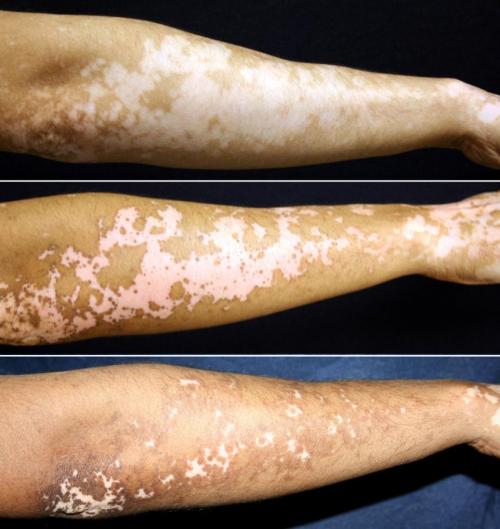Afamelanotide tested as a new treatment for vitiligo
domingo, septiembre 21, 2014
|
 A report was recently published describing a study to test the ability of afamelanotide to improve the response of vitiligo patients to narrow band ultraviolet light B (nbUVB) phototherapy. In short, the treatment worked. I was not personally involved in conducting the study, but I know the study authors personally, and they are great doctors who are well-known vitiligo specialists.
A report was recently published describing a study to test the ability of afamelanotide to improve the response of vitiligo patients to narrow band ultraviolet light B (nbUVB) phototherapy. In short, the treatment worked. I was not personally involved in conducting the study, but I know the study authors personally, and they are great doctors who are well-known vitiligo specialists.
The successful treatment of vitiligo requires suppression of the autoimmune response, followed by regrowth of melanocytes back into the white skin to produce pigment and reverse the white spots. Afamelanotide, produced by Clinuvel, is a synthetic, simplified form of alpha-melanocyte stimulating hormone (a-MSH), which is a natural hormone produced in the skin that stimulates melanocytes to grow and produce melanin pigment. Narrow band UVB suppresses the autoimmune response in the skin and stimulates the melanocyte to start regrowing into the white skin. The authors reasoned that adding afamelanotide to nbUVB treatment would speed up the process of repigmentation by stimulating the melanocytes to regrow and produce melanin faster.
Patients who entered the study were randomized into either nbUVB treatment 2-3 times per week alone, or combined treatment with nbUVB and afamelanotide. Those in the combined treatment group started with 1 month of nbUVB and then received an implant that contained 16 mg of afamelanotide deep in their skin, just above their hip, and nbUVB treatment was continued. The drug diffused out into the entire body, providing a stimulus for all of the melanocytes in the patient’s skin. A new implant was inserted every month for 3 more months, and the amount of repigmentation of the white spots was measured.
The results show that subjects who received afamelanotide in addition to nbUVB therapy regained their pigment faster and to a greater extent than the ones who only received nbUVB therapy. The pigment came back on average 20 days sooner with the afamelanotide, and more pigment returned as well. It worked best for those with darker skin. There were some side effects of the treatment – all of the subjects that received afamelanotide developed darker skin, and 2 of the subjects quit the study because of this. Nausea was reported in 18% and fatigue in 11% of those who were treated with the drug. Some are concerned about the effect of afamelanotide on moles and an increased risk for melanoma, although there was no evidence of changing moles in this study, and there is no evidence of increased risk of melanoma to date.
It is currently not known whether using a larger dose of afamelanotide, using it more frequently, or using it for a longer period of time would produce even better results. The authors didn’t test whether afamelanotide would work on its own, without nbUVB. More studies will be required to determine this, but this certainly looks like a good start!